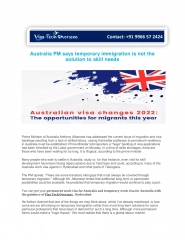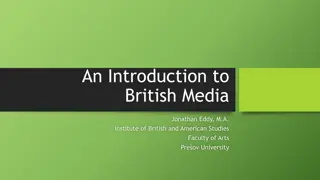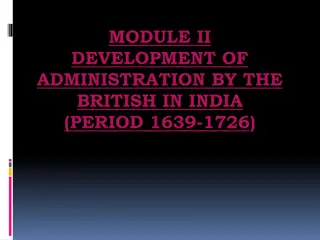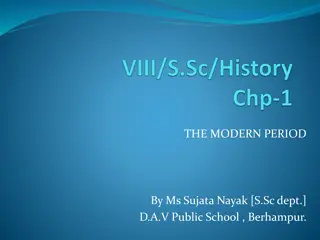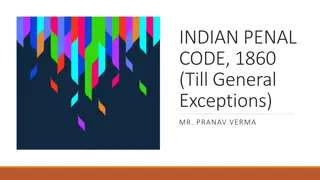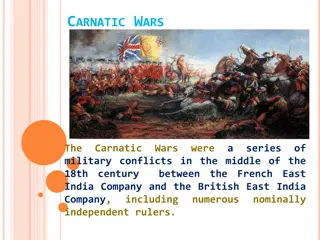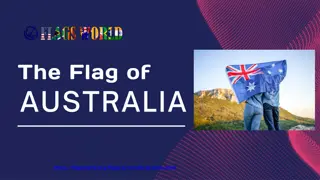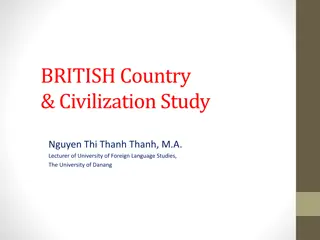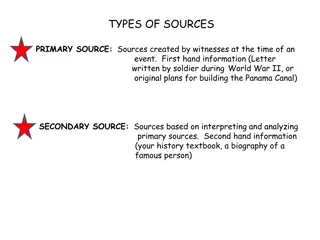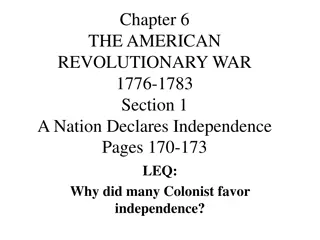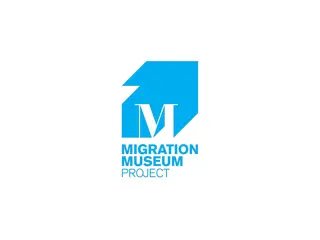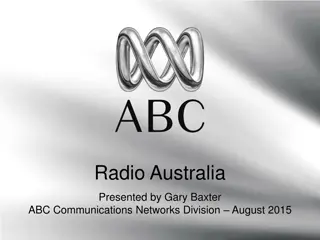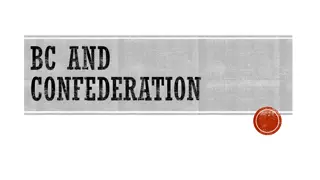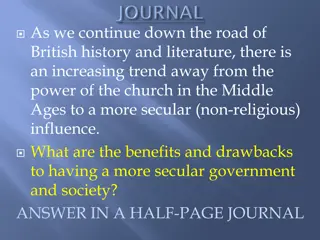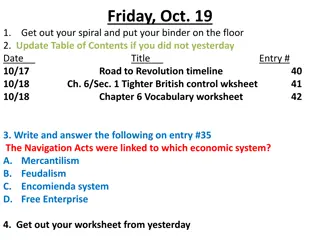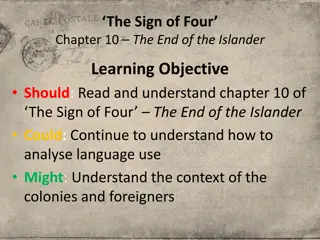History of Australia: From British Convicts to Independence
The passage outlines Australia's history from the arrival of British convicts in 1788 to the establishment of an independent nation by 1901. It highlights the conflicts, societal developments, and impact of imperialism on the Indigenous populations. The text also discusses the formation of an Australian identity and the journey towards nationhood through referendums and the Federation.
Download Presentation

Please find below an Image/Link to download the presentation.
The content on the website is provided AS IS for your information and personal use only. It may not be sold, licensed, or shared on other websites without obtaining consent from the author.If you encounter any issues during the download, it is possible that the publisher has removed the file from their server.
You are allowed to download the files provided on this website for personal or commercial use, subject to the condition that they are used lawfully. All files are the property of their respective owners.
The content on the website is provided AS IS for your information and personal use only. It may not be sold, licensed, or shared on other websites without obtaining consent from the author.
E N D
Presentation Transcript
Year 9 History Starter Sheets Readings
1788 Australia behave British convicts democracy dependent diseases estimated federation fought By 1900 referendums held in each of the six colonies saw voters vote Yes to a new federal Australian f_________________________. This marked the beginnings of a n independent nationhood By the 1880s a growing sense of Australian i____________ had developed throughout the British citizens. Aboriginal and Torres Strait Islanders, South Sea Islanders, Chinese, Afghans and other prosperity was based on cheap land and labour, and the exploitation of agricultural resources such as wool In the 1820 s 30 years after the first European settlement of Australia at Sydney Cove inhabitants, as well as providing lessons on how people should act and b___________ towards each other powerfully influenced by the imperial belief of the r____________ superiority and material progress of 100 000 years ago. At this time, the sea levels were lower, the land was more humid and the animals were with Aboriginal and Torres Strait Islander People who actively resisted the taking of their land but were disadvantaged because they did not have the same kinds of w__________, particularly guns. Shockingly, declined to a quarter of what it had been before European arrival and because of the theft of their land The first Aboriginal Australians are thought to have arrived in A_____________ around Empire democratic values, belief in material progress, racial superiority and imperial greatness. British As new settlers moved into f_____________ regions they frequently came into conflict British it is e______________ that more than 750 000 to 2 million Aboriginals were living in Australia The ordinary Australian had one of the h___________ living standards in the word. The make a new society that was democratic and s_______________ equal for members of their own kind. diseases was smallpox. S___________ alone killed more than 50% of the Aboriginal population living in Island and two in Tasmania. The discovery of a pass through the Blue mountains to the rich agricultural By the beginning of the 20th century a society of British Australians had emerged with a with them a variety of d________ that the Aboriginals had not been exposed to before. One of these Australian society reflected p___________________ beliefs shared by other nations in the British population. This call for nationhood grew louder as the century drew to a close. The settlers wanted to for the Commonwealth of Australia. With the Federal Constitution of 1901 it also had one of the most and the earth. The Aboriginals regarded the earth as the mother of all life. Before the coming of the The British moved into the area now known as Sydney in 1______. The British brought some B_____________ settlers actually would go and hunt Aboriginals for recreation. Contact with imperialism developed differently in Australia because of the influence of isolation, the environment, and wheat and m_______________ resources such as gold and copper. However this prosperity was frontier highest identity mineral powerful religious explained racial resources Smallpox socially bigger. Aboriginal oral tradition and r__________ values are based upon respect for the land and a Europeans were s__________________ to survive in four isolated settlements: Sydney, Norfolk Europeans brought with it killer diseases, alcohol, exploitation and abuse. The Indigenous population new world vision of d________________, social justice and equality for its citizens but was still the vicinity of Sydney. The British also began to take over many of the Aboriginals land and water constitution. On January 1 1901 the six former British colonies became the states of a new nation belief in Dreamtime. Dreamtime was stories that e__________ the creation of the earth and its indigenous Australians, c________________, migrants, powerful trade unions and nationalists. and resources that sustained them, imported diseases, and massacres the Aboriginals became ___________________________________________________________________ b. ___________________________________________________________________ ___________________________________________________________________ lands beyond and the discovery of gold in 1850s led to a rapid expansion of this settlement. Write down the heading. ________________________________________________ ___________________________________________________________________ Highlight 5 nouns. Highlight 5 verbs. Highlight 5 adjectives. Highlight 3 adverbs Write down the words you don t know the meaning of or find difficult to spell. Write down 3 things you have learnt from reading this passage. d_______________ on the British in order to survive. peoples that helped shaped the nation were excluded. gained at the expense of the Indigenous Australians. Year 9 Hist Making a Nation 1 Reading Activity A short history of the settlement of Australia democratic political; systems in the world. and that they had 250 spoken languages. 6. Fill in the missing words. Number the paragraphs. struggling weapons r______________. 2. 3. 4. 5. a. c. 1.
differed in many ways. Each had its own customs & beliefs, music, dance, kinship systems, art forms & thousands of years. When Europeans arrived in 1788, the history of Australia s Indigenous people and of the new colonists changed forever. By the end of the nineteenth century, the Europeans had taken word aborigine comes from the Latin word aborigine , which means an original or native inhabitant of a. _________________________________________________________________________ b. _________________________________________________________________________ c. _________________________________________________________________________ _______________________________________________________________________ _______________________________________________________________________ _______________________________________________________________________ _______________________________________________________________________ _______________________________________________________________________ _______________________________________________________________________ _______________________________________________________________________ _______________________________________________________________________ _______________________________________________________________________ _______________________________________________________________________ These tribal group, had been here for over 60 000 years. Aboriginal and Torres Strait Aboriginal peoples: lived on the mainland & Tasmania, as well as a few small islands off the coast, like Write down the heading. ______________________________________________________ ___________________________________________________________________________ of the First Fleet in 1788, but recent studies estimate there might have been as many as one million that Aboriginal and Torres Strait Islander People were far more productive in their land usage than control of the land and Aboriginal people were not even considered citizens of the country they had No one knows exactly how many Aboriginal people lived in Australia before the arrival The first Australians were called Aborigines by the European colonists in 1788. The the survival of these semi-nomadic hunters and gatherers. Archaeological evidence today suggests ability to adapt and manage their environment. Knowledge of and respect for the land was vital for Islander People survived the harsh Australian conditions for this length of time by developing the ceremonies, due to The Dreaming of the area. There were over 500 languages & 250 dialects of Australia is a large continent on which many different Aboriginal groups lived for Who inhabit the islands off the Torres Strait, between Papua New Guinea & the northern tip of When the First Fleet arrived, the Aboriginals lived in small groups. These groups a country. Many Indigenous people prefer the word Koori , which means people in a number of 3. Circle the metalanguage words : colonists, dialects, estimate, generations, semi-nomadic, Queensland. Other regional names include: Bama in Northern Qld, Yolngu in Arnhem Land, languages in southeast Australia. The name Murri is used in the north of NSW to Central 5. Highlight 5 nouns. Highlight 5 verbs. Highlight 5 adjectives. Highlight 3 adverbs. 4. Write down the words you don t know the meaning of or find difficult to spell. Nyoongah around Perth, Anangu in Central Australia and Palawa in Tasmania. There are two distinct groups of Indigenous peoples in Australia; 6. Write down 3 things you have learnt from reading this passage. those languages spoken around Australia prior to colonisation 8. List 5 numerical facts about Australian Aboriginals. Year 9 Hist Shaping a Nation 2 Reading Activity Palm Island (QLD), Bathurst & Melville Islands (NT). Aboriginal people living in Australia at that time. 7. What is the main point of each paragraph? was first thought by Europeans. Torres Strait Islander peoples: 2. Number the paragraphs. occupied for generations. Aboriginal Australia Australia. iii. iii. iv. iv. ii. ii. v. v. 1. i. i.
doubt but will, like the wood of this vile country when burned or rotten, turn to sand .. . if the nearly worn out, for almost all the seed we have put into the ground has rotted, and I have no nothing but the eternal shrubs, the gum tree and swamp oak stared me in the face-the latter who came out with a design of remaining in the country are now most earnestly wishing to get ______________________________________________________________________ ______________________________________________________________________ ______________________________________________________________________ ______________________________________________________________________ ______________________________________________________________________ ______________________________________________________________________ minister had a true and just description given him of it he will not surely think of sending any I do not scruple to pronounce that in the whole world there is not a worse country than what a. _________________________________________________________________________ b. _________________________________________________________________________ _______________________________________________________________________ _______________________________________________________________________ _______________________________________________________________________ _______________________________________________________________________ _______________________________________________________________________ _______________________________________________________________________ _______________________________________________________________________ Write down the heading. ______________________________________________________ ___________________________________________________________________________ have before us I cannot, I think, give you a more convincing proof than that every person ... more people here . . . Of the general opinion entertained here of the wretched prospect we forbidding that it may with truth be said that here nature is reversed; and if not so, she is c. ________________________________________________________________________ newly settled town like Maitland with its would-be streets marked off by palings and the Major Ross, Captain of the Marines and second in charge of the colony, writes to give his as much resembling our oak as I do an oyster That most melancholy thing in nature is a my first impression was disappointment the soil was so parched, arid and barren and we have yet seen of this. All that is contiguous [connected] to us is so very barren and half-cleared surrounding country, with its blackened stumps left perhaps for the next 7. Make a list of the negative words and phrases used to describe the settlement. 4. Highlight 5 nouns. Highlight 5 verbs. Highlight 5 adjectives. Highlight 3 adverbs. 3. Write down the words you don t know the meaning of or find difficult to spell. generation to uproot why do people make settlements on such land? 5. Write down 3 things you have learnt from reading this passage. 8. Why do you think some early settlers felt this way? Year 9 Hist - Making a Nation 3 Reading Activity 6. What is the main point of each paragraph? impressions of the colony, 2. Number the paragraphs. First Impressions Unknown source away from it. iii. iv. ii. ii. v. 1. i. i.
Awabakal tribe, who lived around Lake Macquarie in the north; and the Darkinjung tribe to the west, whose the source of all power, and who now lives above the sky. Many of the natural features, including the rivers 7. According to Aboriginal tradition who created the Central Coast? ________________________ Ourimbah, in the middle of the Central Coast region, was a ceremonial ground in which boys were initiated. Recent scholarship however increases estimates of the pre-invasion population in NSW four or five times, ____________________________________________________________________________ ____________________________________________________________________________ ____________________________________________________________________________ ____________________________________________________________________________ ____________________________________________________________________________ ____________________________________________________________________________ territory stretched behind the Judge bowling Range, from near the upper Hawkesbury River in the south, Prior to 1788 the country provided an abundance of sea and land food, supporting a healthy an extensive trade network and large ceremonies were held at times of the year when fish were plentiful. According to Aboriginal tradition this region was created by Daramulen, the sky god who is a. _________________________________________________________________________ b. _________________________________________________________________________ c. _________________________________________________________________________ _______________________________________________________________________ _______________________________________________________________________ _______________________________________________________________________ _______________________________________________________________________ _______________________________________________________________________ _______________________________________________________________________ _______________________________________________________________________ The Aboriginals lived by fishing, gathering bush foods and hunting. The region was part of Write down the heading. ______________________________________________________ The relationship between these tribes was very friendly. Reciprocal visits were made each ___________________________________________________________________________ The New South Wales Central Coast Region is located between Sydney and Newcastle, on most of the Central Coast was the country of the Darkinjung tribe. Their neighbours were: the Guringai Awabakal tribes. Although the exact position of tribal boundaries before European invasion is not clear, giving a minimum pre-invasion population of 1,500. Before the invasion there may have 1,500 Kooris in 12 population with few infectious diseases. Accidental injuries from camp fires were quite frequent, and a One local historian estimated the largest native population of the region was about 360. number of people carried the scars of spearing from tribal punishment. Local traditional medicine men, the East coast of Australia. The region covers an area bounded by the Hawkesbury River in the south, The indigenous people of the Central Coast were Kooris of the Darkinjung, Guringai and population who gathered for seasonal events, and visited regularly with neighbouring tribes for trade, Lake Macquarie in the north, the Pacific Ocean to the east and the Judge Dowling Ranges on the west. people, whose country included the shores of Broken Bay and extended south to Sydney Harbour; the ritual and social interaction. Reports made by early European visitors indicate a vigorous and healthy year between the groups and trade items were exchanged. This was accompanied by festivities. Year 9 Hist - Making a Nation 4 Reading Activity - Aboriginal Australia Sheet. 4. Highlight 5 nouns. Highlight 5 verbs. Highlight 5 adjectives. Highlight 3 adverbs. and lakes, were shaped by ancestor, who rests in the swamp at Freeman's Waterholes . 3. Write down the words you don t know the meaning of or find difficult to spell. 9. How many Aboriginals were living in the region before contact with Europeans? called Koradji, used herbal and spiritual treatments for these injuries. 10. What evidence is there that the Aboriginals were very healthy? 5. Write down 3 things you have learnt from reading this passage. family groups living between Hawkesbury River and Lake Macquarie 8. Who were the indigenous people of the Central Coast? 6. What is the main point of each paragraph? and north to the Wollombi Valley. 2. Number the paragraphs.. Central Coast Pre Contact vii. iii. vi. iv. ii. v. 1. i.
acquired special significance. In their seasonal moves to food sources, they followed paths that were as clear to them They also had a different view of the land. The land was there for them to exploit and was something the introduction of alcohol to a society that had no knowledge of it and had not built up social restraints to limit massacres of innocent men, women and children in retaliation for something like the spearing of a sheep for food ____________________________________________________________________________ ____________________________________________________________________________ ____________________________________________________________________________ ____________________________________________________________________________ The Europeans believed that one could not distinguish between the practice of the Chrlstian religion Some of the failures of those Europeans who did try to preserve Aboriginal society came from their cared for it. Survival depended on each person sharing what he or she had with the group as a whole. Particular sites a. _________________________________________________________________________ b. _________________________________________________________________________ c. _________________________________________________________________________ _______________________________________________________________________ _______________________________________________________________________ _______________________________________________________________________ _______________________________________________________________________ _______________________________________________________________________ they could own; a piece of paper called a 'title' was proof of this ownership. For them it seemed that the Aboriginal Write down the heading. ______________________________________________________ When the European settlers arrived in Australia they who had came into contact with a people lived lack of understanding of Australian Aboriginal culture. Over 50 000 years, Aboriginal Australians had established a ___________________________________________________________________________ same thing. They believed that their technological superiority in things like guns and ships, the knowledge of which government policies to isolate and divide Aboriginal communities o a disruption of their social and cultural life. government support. There were also individual Europeans who had some understanding of the Aboriginal situation Three aspects of the British way of life caused the 'seeds of conflict between the European and on one hand and their civilisation on the other. They spoke of 'Christianity' and' civilisation' as being one and the Australians just randomly moved over the land; and if the Europeans took some land, the Aborigines could just as close physical and spiritual relationship with their land. They knew that the land would care for them only if they as roads are to us. Their religious beliefs and their rules for behaviour towards their own and other groups were consequences of the invasion, consequences sometimes intended and other times not intended, led to widespread extremely complex. In the absence of a written language. beliefs, practices and knowledge were conveyed from These factors were significant in Aboriginal and European relationships in all of the colonies well into the 20th on this land for thousands of generations. For these original Australians, it was an invasion of their land. The There were Aboriginal leaders who fought against the invasion and others who tried to get 4. Highlight 5 nouns. Highlight 5 verbs. Highlight 5 adjectives. Highlight 3 adverbs. 3. Write down the words you don t know the meaning of or find difficult to spell. 7. List the factors that led to the widespread suffering of the Aboriginals. . the idea of private property such as fencing off land to stop others from entering. and tried to protect them, but sometimes in ways that actually caused other problems. had been built from many generations and many civilisations, made them superior. 5. Write down 3 things you have learnt from reading this passage. Year 9 Hist Making a Nation 5 Reading Activity generation to generation through song, art, stories and dance. suffering and death. This came about through many factors: the occupation of land on which their living depended . the importance of accumulation of material wealth imported diseases to which they had no resistance 6. What is the main point of each paragraph? 2. Number the paragraphs. . the use of human labour easily move somewhere e1se. Conflicts between societies European settlement Aboriginal Society European Society Noongar peoples: its effects century. iii. iv. ii. v. 1. i.
Possibly 3000 Afghan cameleers came to Australia from the 1860s to 1901, but not all were from horse teamsters and the Afghan cameleers. There was negative propaganda in the newspapers about the strange harsh interior of Australia, until railways and motor vehicles took over from them in the 1930s. The camel trains moody camels. Most significantly for the Australians who owned horse and bullock teams, the cameleers worked stations. They established communal resting places, called Ghan towns or camel camps, on the outskirts of towns Telegraph, the railways into the Western Australian goldfields and the Trans-Australian Railway. The cameleers provided essential transport to the largest town in the area, Coolgardie, until the railway reached there in 1896. Australia before 1901 were able to apply for an exemption from the dictation test and renew their contracts to The cameleers had a strong work ethic, a respect for the law and an understanding of the often- and flourished!. Today, the train that travels between Adelaide and Darwin is called The Ghan after the Afghan also a widespread belief in the superiority of 'white men which led to tension between the European bullock and 8.How did they contribute to the development of Australia? _______________________________ ____________________________________________________________________________ ____________________________________________________________________________ ____________________________________________________________________________ With the development of road and rail transport, the need for camels declined. Some cameleers were strong and skilful, coordinating as many as 70 camels in a team. They also were able to secure heavy loads a. _________________________________________________________________________ b. _________________________________________________________________________ c. _________________________________________________________________________ _______________________________________________________________________ _______________________________________________________________________ _______________________________________________________________________ _______________________________________________________________________ _______________________________________________________________________ _______________________________________________________________________ Afghanistan. Afghan was a general name given to men from India, the Kingdom of Afghanistan and present-day The wide streets in Coolgardie are evidence of the importance of providing enough turning space for the camel Afghans). All were single Muslim men who had signed three-year contracts to live and work in central Australia. Write down the heading. ______________________________________________________ 7. Who were the Afghans? _______________________________________________________ During the 1880s, trade unions sought to maintain high wages for European workers. There was remained in Australia, while others returned to their homelands. What happened to the camels? They adapted for low wages. The cameleers moved goods across Australia as they supplied mines and inland cattle and sheep ___________________________________________________________________________ Pakistan, who led camel teams in outback Australia. Australians referred to them simply as 'Ghans' (short for Immigration Restriction Act. Many failed the dictation test. However, cameleers who had spent many years in and settlements. They did not mix with the European population, although they sometimes married Aboriginal women. Among the small number of tin-covered huts, which often included a small mosque, they ate specially desert conditions carrying great loads. They provided an essential service to people living or working in the Camels had earned a reputation as 'ships of the desert' due to their ability to survive harsh distances. The camel teams have been called the 'backbone of the Australian economy' during the 1870s to early 1900s as they carted the supplies and equipment to assist major developments such as the Overland carried a wide range of goods, including food and water, wool, mail and construction equipment over great New cameleers were restricted from entering Australia following the l90l During the early 1890s many cameleers came to the Western Australian goldfields. They prepared food and non-alcoholic drinks. Australia's first mosque was constructed at Marree in 1861. 4. Highlight 5 nouns. Highlight 5 verbs. Highlight 5 adjectives. Highlight 3 adverbs. 3. Write down the words you don t know the meaning of or find difficult to spell. 5. Write down 3 things you have learnt from reading this passage. cameleers who worked on the construction of the original rail track. ____________________________________________ Year 9 Hist Making a Nation 6. Reading Activity 9. Why were the Afghans seen as a problem? 6. What is the main point of each paragraph? Experiences of the Afghan cameleers strings (teams or groups of camels). 2. Number the paragraphs. way of life of these 'aliens'. with a single length of rope. AFGHAN CAMELEERS lead camel teams. iii. vi. iv. ii. v. 1. i.
household primary three wealthier Australia assisted businesses convict domestic encouraged enjoy paid transportation ___________ their own way. Convicts and settlers who came to Australia found that in comparison to and ______________ the prosperity. Women migrants were also assisted to curb a gender imbalance To curb the dominance of the squatters and to end the system of free ______________ labour, the entire British Empire. Housing booms in Sydney and Melbourne in the 1880s led to the creation of new This was to create an emancipist (free people) consumer economy and improve the moral outer suburbs connected by road, rail and tramway. At the close of the nineteenth century, almost of With increasing numbers of free migrants and the desire of Colonial society to be free a. _________________________________________________________________________ b. _________________________________________________________________________ c. _________________________________________________________________________ Colonial Government decided to promote the migration of free settlers and limit squatter land leases in the colonies, to work as ___________________________ servants and to foster marriages and Write down the heading. ______________________________________________________ The influx of _____________________________ due to the gold rushes of the 1850s led to the childbirth. These migration schemes resulted in ___________ people coming to Australia between At this time, families woke at _______________and lit the stove to warm their houses which were ___________________________________________________________________________ rapid development of cities such as Sydney, Melbourne and Adelaide. By 1888, Melbourne had grown work because ____________appliances such as washing machines and dishwashers did not exist at Children went to ________________school to learn basic reading, writing and arithmetic and left Bed mattresses were made of horsehair or _____________; only the rich could afford coil-spring They ________________________ their relatives in England to come to Australia Women stayed home with the children and attended to ____________duties this was very hard tone of the colony. The Colonial Government _________________ some migrants by paying their _______________________________ to NSW in 1852. Between 1788 and 1868 approximately to become the ___________________________city in Australia and the second largest in the _________________________ alongside the wealthy squatters - who of course were not very school at the age of 12 and went straight to work. Children from _______________ families Europe, conditions were very good and with hard work and determination they could prosper. The chamber pot was emptied and breakfast was ___________in a wood fired or gas stove About one third of migrants who came to Australia between 1830 and 1850 A Day in the Life of Average Australians at the beginning of the 20th Century 4. Highlight 5 nouns. Highlight 5 verbs. Highlight 5 adjectives. Highlight 3 adverbs. 3. Write down the words you don t know the meaning of or find difficult to spell. this time; washing clothes and food preparation could easily take an entire day to Men spent most of the day _____________and there was little time for leisure In the early 1900 s, the average Australian family had _______children of the hated 'convict stain', the Colonial Government decided to cease fare to ______________________ and helped to set up farms and 5. Write down 3 things you have learnt from reading this passage. complete cooked daybreak electric feathers Year 9 Hist Making a Nation 7 Life in the 1900 s Australia's 3.76 million people lived in urban centres. 1830-1840s Assisted immigration Introduced Immigrants largest two-thirds 160,000 convicts were sent to Australia. sometimes went to secondary school. happy with such competition. 2. Number the paragraphs. cooler than houses today ________________. 1815 and 1840. to 14 years. mattresses The Cities working 58,000 1.
was the nightman's job to collect the sewage from each house and dispose of it in the nearest in the early 1900s people still dumped human waste into open cesspits in their yards or used it in the early 1900s diseases that are easily preventable today killed many australians the main industries such as tanning, which produced animal wastes, were kept well away from the more behind each backyard ran an alleyway just large enough for the nightman's horse and cart. it a. _________________________________________________________________________ b. _________________________________________________________________________ c. _________________________________________________________________________ childbirth often occurred at home with a midwifes assistance if you were lucky death during Write down the heading. ______________________________________________________ this was mainly due to unsanitary conditions such as doctors not washing their hands before ___________________________________________________________________________ in the early 1900s hospitals were often places where people would die rather than be cured toilets were usually nothing more than a tin bucket located in the backyard 'dunny' or shed. these conditions provided a breeding ground for carriers of disease such as rats and fleas. baths were uncommon most people had a weekly bath and daily would wash their underarms people tried to cure themselves when they got sick. doctors $ (no free public health care) killers were tuberculosis typhoid diarrhea and diphtheria smallpox and the bubonic plague antibiotics that are now used to treat many of these diseases were not invented until the densely populated working districts by the water were therefore often characterised by people started washing their hands before eating and preparing food and more efficient food inspectors began checking the quality of food being sold by grocers and butchers in areas without sewerage human excreta was deposited in an outside dunnycan in the poverty was a daily reality for many unskilled workers. inner-city areas within walking in 1900 the average life expectancy of an australian was 54 years it is now 75 years. high rents often forced several families to cram together inside hastily built slums. 4. Highlight 5 nouns. Highlight 5 verbs. Highlight 5 adjectives. Highlight 3 adverbs. performing surgery as well operating with equipment that was not sterilized 3. Write down the words you don t know the meaning of or find difficult to spell. appliances to wash clothes greatly reduced the spread of deadly diseases distance of the factory or workplace were overcrowded and unhygienic. Year 9 Hist Making a nation 8 Reading activity Health and Hygiene indoor toilets were rare so chamber pots or potties were common as fertilizer for their gardens even in the wealthier suburbs 5. Write down 3 things you have learnt from reading this passage. downstairs neck and face with a sponge bath from a bowl outhouse and collected by the night soil man offensive smells and piles of rotting garbage. 1 in 3 children died in first year of life 5. Put in the fullstops, commas and capitals affluent outer suburbs childbirth was common 2. Number the paragraphs. were also common waterway. 1940s 1.
If a man lost his job there was no centrelink to pay him a fortnightly dole chegue. People had to rely on Factories were crowded and poorly ventilated and often very durty. There were few safety regulations employer since it meant that a worker went unpaid when demand was low. Unskilled workers had to look for from the class distinctions of the Old World. Reforms such as the eight-hour day, however, were available The basic wage of $4.20/week was the minimmum amount that one could be expected suppport a wive and 3. Circle the metalanguage words : Conditions domestic egalitarian minimum sexist trade unions For the majority of non-union workers, Australia was far from a paradise. Women, children, below the trade union award, or minimum industry rate. Many such workers did not have the protection of a. _________________________________________________________________________ b. _________________________________________________________________________ c. _________________________________________________________________________ In a male-dominated society in which women tended to remain in the private sphere, sexist By the end of the century, Australia had earned a reputation as an egalitarian society free a union and were forced onto individual contracts that strongly favoured the employer. Unskilled workers Write down the heading. ______________________________________________________ married women were expected to raise children and take care of the family. The main form of work for a Because only trade unions could deal with this coort, many more workers began to join unions in order to hours a week for wages as low as 1 a week, with no extra pay for overtime. Qualified tradesmen earned ___________________________________________________________________________ Even after governments passed laws to improve conditions for workers, conditions remained pour at the attitudes were widely accepted. Most women were considered dependants that is, earning no income of In 1904, the federal government established the commonwealth court of conciliation and arbitration to non-European immigrants and Aboriginal People continued to work long hours and were paid at rates well These things all contributed to the belief of meny people that austrayla was a 'working man's paradise their own of their fathers or husbands. The few women who worked tended to be young and single, as often poorly ventilated and stifling in the heat of a summer. Unskilled workers could work for up to 48 typically men of Anglo-Celtic background Australia was a working man's paradise. They worked fewer Shop assistant hours: 9am-9pm on weekdays, 9am-11pm on weekends. They were not permitted to sit Nevertheless, conditions in factories were very poor by today's standards. These were tended to be paid by piece-rate (gives a payment for each item produced). This also advantaged the only to skilled workers belonging to trade unions. For those able to obtain trade union membership young woman was domestic service, which meant being a housemaid, a cook or a nanny for wealthier This was because many "bosses" chose to ignore the knew laws and often fired any worker that hours, received more pay and enjoyed more rights than workers anywhere else in the world. There was no such thing as superannuation, long service leave or sick-leave entitlements. 5. Highlight 5 nouns. Highlight 5 verbs. Highlight 5 adjectives. Highlight 3 adverbs. 4. Write down the words you don t know the meaning of or find difficult to spell. other employment at such times, making rent payments almost impossible to meet. and accidents were commen. There was little chance of recieving compensation. Basic workers compensation and maternity allowances were also introduced families. Educated middle-class women usually became teachers or nurses. 6. Write down 3 things you have learnt from reading this passage. Workers could walk up to 10 kilometres to and from work everyday One hour diner break allowed. This was the same for labourers. From 1909, pensions were payed to people over 65 years of age settle disagreements betwen workers and their bosses Working Conditions in 19th Century Australia Put in the Capitals and find the spelling mistakes Year 9 Hist Making a Nation 9 Reading activity have the right to be protected in this court Unskilled working man's paradise beginning of the twentieth century complained or joined a trade union relatives, freinds or charities. 2. Number the paragraphs. down during work hours. up to 3 a week. three children 1.
first electorate in the world to introduce the secret ballot. south australia followed two weeks later and in should be. today it is still seen as a symbol of resistance. the rebellion took place during the gold rushes of south australia and new south wales soon followed with similar reforms, earning australia the reputation as democratic rights and colonial self-government. australia come lo be seen as a land of opportunity, but the parliaments to adopt a wide range of political and social reforms. among the ideas debated by enthusiastic influential political ideas that first appeared during the l8th century in europe and america the gold rushes marked a turning point in australia's history, prompting a massive scramble a. _________________________________________________________________________ b. _________________________________________________________________________ c. _________________________________________________________________________ d. _________________________________________________________________________ e. _________________________________________________________________________ wales, victoria, south australia and queensland swelled during the 1850s, great britain provided them with Write down the heading. ______________________________________________________ although the authorities had swiftly crushed the eureka rebellion, widespread support for the world as 'the australian ballot'. within a year of the eureka rebellion, the government of victoria had ___________________________________________________________________________ liberalism: the widespread acceptance of freedom of speech, the press and religion in a society; and socialism: the promise of improved conditions for working class people through an increased role of the eureka rebellion of l854 is seen by many historians as a milestone in the struggle for 1858 new south wales passed similar legislation. as a result, the secret ballot became known throughout nationalism: the features of australian colonies that made them distinct from other nations in the were debated in colonial australia during the 1800s. these ideas would shape and influence the political the arrested miners forced the government to come to terms with their demands. victoria became the democratic rights and a more equal society. it was partly a conflict over what kind of society australia of people from overseas to the australian goldfields. the population trebled in the first decode of the the arrival of european and american prospectors during the gold rushes in the eastern also introduced pay for parliamentarians, annual elections and the removal of properly rules for voting. colonies brought new and exciting political prospects for the colonies. as the population of new south rushes and wealth from gold raised living standards. these developments paved the way for more during this process and for the next 50 years, groups pressured the new colonial 3. there should be no property (land holding) qualifications to become a member of parliament. chartism: a series of democratic reforms arising from the 1b3b people's charter in britain 4. Highlight 5 nouns. Highlight 5 verbs. Highlight 5 adjectives. Highlight 3 adverbs. all men over the age of 21 would be given the right to vote universal male suffrage 3. Write down the words you don t know the meaning of or find difficult to spell. representative democracy: the inclusion of representatives of eligible voters in Influential political ideas that shaped the creation of the Australian Nation the opportunity to create their own democratic governments and constitutions. rushes also had other consequences, including violent political protests. 5. Write down 5 things you have learnt from reading this passage. 2. a secret ballot the (private vote]) would be used during elections the protection of individuals in the privacy of their own homes egalitarianism: equal opportunity for citizens of a country Year 9 Hist Making a Nation 10 Reading Activity culture and institutions of the australian colonies. the government in the economy and society 4. all members of parliament should be patd. 5. all electorates should be of equal size the political decision-making process 6. elections should be held every year the aims and values of the chartism ,a laboratory for democracy'. 2. Number the paragraphs. 6. Insert capital letters. the eureka rebellion colonists were: the l850s. world. 1. 1.
place, only the House of Representatives can decide to impose taxation and spend money (that is, introduce be part of Parliament for three years. Senators would be elected for six years. In addition, there would be appointed by the monarch, but in practice the monarch accepts the person recommended by the Australian 7.How is the government formed? ___________________________________________________ 2.Who is their representative? _____________________________________________________ 'money Bills'). secondly, the government is created by the political group or groups that have a majority of 12.What is the Senate s role? ______________________________________________________ 10.What is a Minister? ___________________________________________________________ 4.What is a voting area called? _____________________________________________________ containing about 30 000 voters. These members would be chosen or elected by the votes of Australians to 11.Who is the cabinet? ___________________________________________________________ 8.Who is the Prime Minister? ______________________________________________________ Labor forms the government and its leader becomes Prime Minister. If neither major party has a majority ____________________________________________________________________________ ____________________________________________________________________________ 6.How is this determined? ________________________________________________________ 5.How many senators are elected? __________________________________________________ 3.What are the two houses of parliament? ____________________________________________ 1.Who is the Head of State in Australia? _____________________________________________ 9.Who is the opposition? _________________________________________________________ These include defence, foreign affairs and Aboriginal affairs, but the most important minister, after the The Senate and the House of Representatives are made up of politicians elected, or voted, refused to pass the Bill or Bills, the two houses of Parliament would meet together in a joint sitting and a into power by the people. At the conferences that led up to Federation, participants decided there would The government of Australia has three tiers or levels and the constitution outlines powers from the House of Representatives twice in three months, then there could be a double dissolution. Both deadlock, the men who wrote the Constitution decided that if the Senate refused to pass a proposed law The Prime Minister selects some members of Parliament (from his or her own party) to be If, for example, the Labor Party has the most members in the House of Representatives, houses would be dissolved (or closed) and a general election held. After the election, if the Senate again Prime Minister is the Treasurer. The Treasurer is responsible for raising and spending money The Prime the new federal parliament, whose laws would apply to all of Australia and not just a particular colony or Parliament's main task is to make laws. The men who wrote the Constitution decided that both parties must come to an arrangement with independent members to form a government. The party an equal number of senators - originally six and now twelve elected from each state, regardless of each state, would consist of Britain's monarch as head of state (the king or queen), a senate (the 'upper' or In theory the House of 'Representatives is more powerful than the senate. In the first Representatives. If it did this repeatedly, the work of government would grind to a halt. To avoid this Since it was clear that the monarch did not live in Australia, a Governor-General was to The Senate is not without power. It may refuse to pass Bills sent to it by the House of Members of the House of Representatives would represent electorates (voting areas) represent the king or queen in Australia. The Constitution states that the Governor- General is to be other ministries. These men and women manage different parts of the government's responsibilities. . local government (hundreds of shires or local councils administered by the State Governments). Minister and senior ministers meet together as the Cabinet - it is here that the most important be twice as many members of the House of Representatives as there would be senators. with a minority of members in the House of Representatives is called the Opposition. . the Commonwealth Government, also called the Federal or National Government Year 9 Hist Making a Nation 11 Reading Activity Parliament in action for the Commonwealth and State Governments. The three tiers are: 'states' house') and a House of Representatives (or 'lower house'). simple majority vote would be taken to decide the issue. . the six State Governments (the colonies before l90l) The Role of The House of 'Representatives politicians in the House of Representatives. government decisions are made. Three levels of Government The Role of The Senate state's population. Prime Minister.
Act Aldermen Autocratic Bicameral Parliament Bill Cabinet Compulsory voting Conservative Constitution Constitutional Democracy Democracy Electorate Federation Government Governor Governor - General Lower house Mayor Ministers Monarch Parliament Preferential voting Premier Prime minister Radical Referendum Representatives Royal assent Self - government Senator Upper house Year 9 Hist Making a Nation 12 Government Terms definitions Voting area Members of the local council Leader of the local council Leader of the state government Queen s representative in Australia Leader of the Australian government Group of senior ministers The Senate The House of Representatives Queen s representative in the State Joining together to form a nation A proposed law A bill that has been passed by both houses and given royal assent The approval of an Act of Parliament by the monarch or representative A system of government that has two houses of parliament System of government where representatives are elected by the people A member of the Senate Government by the people A system of voting where if a candidate does not get half the votes then the preferences of the least popular candidate is used to determine the winner A person elected by voters A type of government where all decisions are made by one person Where a nation rules itself Those responsible for a particular area of government Where it is illegal not to vote A person who seeks to maintain existing institutions A person who promotes reform of existing institutions Makes laws and is elected by the people Is the party or coalition that won the election A set of rules for how a government operates The king or queen A vote to change the Constitution


